Getting From Sustainable Design to Carbon Neutral Design
Extending the sustainable design criteria to incorporate a new focus on low carbon practically infers that designers apply increasing levels of rigor in the adoption and incorporation of codes and protocols. These could be incrementally outlined as:
1. Basic Code Compliance – meeting local building codes, national building codes, ASHRAE, and other legally required standards.
2. Applying LEED®, Green Globes, GBI, ASHRAE 189.1 standards in design – targeting the highest level of compliance for the chosen protocol, recognizing that compliance with any of these does not necessarily infer that the highest performance standard has been achieved for all parts of the building and site, and that carbon is not presently accountable under any of these measures.
3. Focus on Zero Carbon or Carbon Neutral – design of the building and its functions to minimize its direct and indirect contribution to carbon emissions. This could include analysis of both the components that comprise the various systems in the building as well as the overall energy performance of the building. Aggressively, this also includes the functional use of the building and the transportation requirements of the occupants.
It is also helpful to invoke Life Cycle Assessment in the design process. Life Cycle Assessment is a tool that feeds into the decision making process for various aspects of each of these strategies. There are carbon issues associated with material choices as well as the longevity of components. The current version of the Eco-Calculator that is published by The Athena Institute focuses on carbon values on the basis of prescriptive choices in building systems. This tool is available as a free download and is presently developed for Low-Rise versus High-Rise buildings based on climate data for a limited number of cities. The Athena Eco Calculator is incorporated into the new GBI Standard that is under development. The Athena Eco Calculator is incorporated into the new GBI Standard that is under development.
It must also be stated that beyond basic code compliance, LEED® and Zero Carbon principles are neither mutually inclusive nor mutually exclusive. They can be applied to the design of the building in any sequence or selectively. They are listed in this order as by the degree of magnitude of difficulty, they tend to have a somewhat logical progression, or difficulty to achieve, in this particular order. There are aspects of the general LEED®, Green Globes, GBI or ASHRAE 189.1 categories that can easily feed into the low carbon design and assessment.
Targeting Carbon: Reduce, Renew, Offset
Holistic carbon neutral design is looking to reduce the carbon emissions associated with all aspects of the project. This would include the construction and materials, operating energy as well as the carbon associated with the commercial, institutional or residential use of the building by the occupants. This incorporates the nature of the work or activity that is carried on within a building. Locating the building to reduce transportation costs will factor into this equation, and thereby includes neighborhood and local or regional planning issues.
Zero Energy Design differs from Carbon Neutral Design in that it is more concerned with the reduction of the operating energy requirements for a building, focusing on the eventual use of zero fossil energy. The official ASHRAE definition for a Net Zero Energy building is “buildings which, on an annual basis, use no more energy than is provided by on-site renewable energy sources.” The Office of Energy Efficiency and Renewable Energy provides an array of definitions for Net Zero Energy Buildings, based on the base premise that, “A net ZEB produces as much energy as it uses over the course of a year. Net ZEBs are very energy-efficient buildings, with the remaining low energy needs typically met through the use of on-site renewable energy.” The Department of Energy provides supplementary definitions based upon the cases of Net Zero: Site Energy, Source Energy, Energy Costs, Energy Emissions and Energy. Preferred renewable resources would be solar and wind, but renewable resources can include biomass, wood chips and other waste materials, as long as they are from renewable sources. Obviously the burning of any type of fuel, fossil or renewable, results in carbon emissions – creating one of the significant differences of the goals of Zero Net Energy and Carbon Neutral Design. The Department of Energy provides supplementary definitions based upon the cases of Net Zero: Site Energy, Source Energy, Energy Costs, Energy Emissions and Energy. Preferred renewable resources would be solar and wind, but renewable resources can include biomass, wood chips and other waste materials, as long as they are from renewable sources. Obviously the burning of any type of fuel, fossil or renewable, results in carbon emissions – creating one of the significant differences of the goals of Zero Net Energy and Carbon Neutral Design.
ZED and CND Building Characteristics
The design process for a Carbon Neutral Building is quite differently framed from a standard code compliant building. It is essential that an Integrated Design Process / Team Approach is used from the outset of the project to ensure success.
The general characteristics of Zero Carbon Buildings begin to differentiate them from other buildings. There are rudimentary differences in the recognition of the site and climate as well as the pervasive incorporation of passive design principles.
ZED and CND buildings:
- begin the design with a positive acknowledgment of their climate, location and orientation
- take advantage of the sun to reduce their energy requirements
- take advantage of the wind to reduce their energy requirements
-
employ a high degree of passive solar heating to reduce their energy requirements
- emply a high degree of
natural ventilation to reduce their energy requirements
- manipulate the microclimate around their buildings to temper the environment
- use shading devices and vegetation to control summer over heating
- employ a high degree of
daylighting to reduce their energy requirements
- have a broader acceptable range of temperature and humidity when assessing occupant comfort
- are typically
super insulated if located in a cool to cold climate
-
use higher quality glazing systems to control heat flow
-
interior finishes include thermal mass to store the free heat they capture from the sun
- use highly efficient mechanical, electrical and plumbing equipment
-
generate their own electricity through wind turbines, photovoltaics and micro generation facilities
- their goal is to be able to generate more electricity than they require for operation
- include occupant education as part of their design strategy to ensure the proper, energy efficient long term use of the building
To build carbon neutral also suggests a paradigm shift from the classic 3 Rs, reduce, reuse and recycle, to Reduce, Renew and Offset:
Reduce - build less, protect natural ecosystems, build smarter, build efficiently.
Renew - use renewable energy, restore native ecosystems, replenish natural building materials, use recycled and recyclable materials.
Offset - compensate for the carbon you can't eliminate, focus on local offset projects. Carbon offsetting is gaining popularity, but it needs to be remembered that purchased offsets cannot be generated in adequate quantity to perpetuate and sustain our current practices.
Reduce:
The notion of reduction is critical as a starting point for low carbon strategies. The idea of increased energy efficiency in building design has been integral to green design strategies since the Oil Embargo of the 1970s. The byproduct of energy efficiency has been a reduction in the requirement for energy to heat and cool buildings. In Northern climates, this has been the direct result of increasing insulation levels and airtightness in construction. The natural extension of this idea leads to the reduction in the requirements for fossil fuels to heat and cool buildings. Fossil fuel reduction leads to a reduction in carbon.
The idea of widespread reduction in the size and scope of projects in their entirety is new to the carbon argument. There have been criticisms levied at “green homes” that have been in excess of 4,000 square feet in size. Can a building be properly labeled as sustainable, if its use of materials and space is exceeds any sense of modesty in proportion to the base program requirements? Some movement in limiting residential areas for sustainable buildings is underway in revisions to current assessment systems and in the new ASHRAE standard that is under development. However, in the ASHRAE standard, the maximum size of residential units that form part of a High Performance Green Building is only part of the Optional system of compliances. No Option is provided for the reduction of commercial or institutional spaces. In part, including such an option in a standard would be problematic. Where there are fairly clear minimum space requirements associated with a residential program, the program requirements for non residential buildings are far less fixed, even if measured on a square foot per person basis. A greater level of creativity is necessitated in approaching commercial and institutional design with a mind to the reduction of area and volume. Most in the design profession would consider such an infringement on their design freedoms. However, in the ASHRAE standard, the maximum size of residential units that form part of a High Performance Green Building is only part of the Optional system of compliances. No Option is provided for the reduction of commercial or institutional spaces. In part, including such an option in a standard would be problematic. Where there are fairly clear minimum space requirements associated with a residential program, the program requirements for non residential buildings are far less fixed, even if measured on a square foot per person basis. A greater level of creativity is necessitated in approaching commercial and institutional design with a mind to the reduction of area and volume. Most in the design profession would consider such an infringement on their design freedoms.
Reduction in the scope and size of a commercial building could also be considered to be a red herring where Architectural fees are levied as a percentage of the construction cost. There is a disincentive to build less as there could be seen to be a reduction in fees. Nonetheless, the base principle of “building less” guarantees a decreased use of material resources (and the associated carbon that accompanies their production and transportation to the site). Building less also facilitates reductions in operating energy as it would be assumed that the volume to heat and cool would be proportionately smaller. Building less might have a positive impact on the use of the site, leaving more residual space for both landscaping as well as the harvesting of renewable energy. This will work to protect the natural ecosystems on the site as there should be impact reduction through a smaller building. Natural ecosystems can be calculated to generate oxygen – thereby naturally offsetting carbon production on the site.
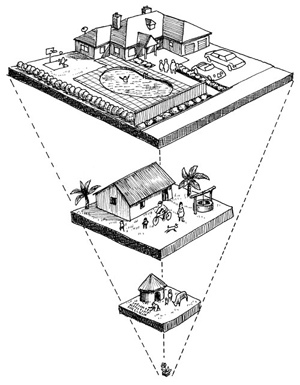
Our Ecological Footprint - Less is Less
In many ways the notion of reduction work with current intiatives to "footprint" our lifestyles. Ecological footprinting began by tying personal lifestyles to "the number of planets required to sustain your lifestyle". Most of the personal calculators have been upgraded to also include an assessment of the connection between lifestyle and carbon.
Reduction can also infer "reuse", both of a base building as well as its components. LEED® already awards credits for the reuse of buildings in its Materials category. Material and buildng reuse de facto eliminates the carbon that would be part of new product production. Reusing materials (with little remediation) is preferable to the use of recycled materials or materials with recycled content as energy (carbon) is normally part of any process associated with recycling materials.
Renew:
The notion of “renew” builds on principles of sustainable design already in practice. The use of renewable energy is already addressed and promoted in LEED®, Green Globes, GBI and in ASHRAE 189.1. Only the new ASHRAE standard promises to mandate a certain percentage of renewable energy in a project. As of the state of the document in May 2008 on-site renewable energy power systems with a peak electrical generating capacity of not less than 1.0% of the electrical service load were to be required. There has been some criticism that this amount is insufficient to have a true impact on the overall energy requirements for the building, so this might be revisited.
LEED® Credits 2 and 2.1 in Energy and Atmosphere reward one point each for the Supply of at least 5% or 10% of the building’s total energy use (as expressed as a fraction of annual energy cost) through the use of on-site renewable energy systems. Green Globes also uses the references of 5% and 10% for the integration of renewable energy sources such as solar, wind, biomass, or photovoltaics with reference to the total load of the project. The revised GBI Standard allots 50/1000 points for the use of off-site and on-site renewable power. When looking to design to zero carbon, it is desired that ONLY renewable energy be used to provide a level of heating and cooling comfort that is unable to be produced by the passive functions of the building alone. This differs substantially from any of the current protocols in terms of “extent” of reliance on renewable energy as most assume that even the best projects will be maxed out at a significantly lower level.
The use of renewable materials is addressed in all protocols. ASHRAE Standard 189.1 includes the use of renewable materials, those with lower impact, and those with recycled content in its optional prescriptive requirements. It mandates construction waste management as well as the use of certified wood products. LEED® awards a significant number of total credits based upon the reuse of the building (3), construction waste management (2), use of materials with recycled content (2), resource reuse (2), local/regional materials (2), rapidly renewable materials (1) and certified wood (1). None of these are mandatory credits. Green Globes allocates 100/1000 available points to encourage the use of low impact, renewable and reused materials. Again, these are all optional.
The analysis of the impact of materials through Life Cycle Assessment is a Performance Option in Standard 189.1. Durability of materials is a Credit in the Canadian LEED® system. Green Globes devotes 15/1000 points for durability, adaptability and disassembly. These more complex credits are of interest to a carbon neutral project. The use of a Life Cycle Assessment analysis can facilitate and examination of the carbon costs of the building materials. Durability offers something similar in that the longevity of the building and its components can reduce the long term carbon cost of a building. Replacement of materials and systems with a short life span increases the carbon cost of a building over its lifetime. The intention is that a carbon neutral building be durable as not to incur a carbon debt over time. Design for disassembly increases the complexity of the design of a project but does offer the potential of short circuiting the cradle to grave cycle of a building, thereby saving future carbon.
The relationship between any of the material credits and carbon neutral design is more difficult to define. Holistic sustainable motivation would offer that renewable materials are simply better because earth’s resources are in finite supply. The carbon argument examines the value of different materials based upon their carbon costs, both in fabrication, transportation and site assembly. Any carbon costs associated with the materials themselves must be offset by the ability of the site to absorb the same carbon. The restoration of native ecosystems on site is looked at as a means of providing for increased capacity of the site to sequester or process CO2 into oxygen. The use of local materials is of obvious benefit as it has the potential of drastically reducing the carbon associated with transportation.
It is the complexity of the building materials issue that has led the current initiatives towards carbon neutral design to set this aspect of the building aside and concentrate on operating energy. The latter is far easier to define and therefore calculate.
Offset:
Offsetting (i.e. purchasing credits from others who are able to prove that they are able to absorb your excess carbon by some means) might be considered the last line of recourse to bring a project to a carbon neutral state. Site conditions for many projects can place constraints on the viability of using your own renewables. Limited site area, incorrect exposure for solar and PV, overshadowing, etcetera will restrict the output of site located systems. Offsetting and carbon trading are becoming an increasingly popular way to look at compensating for the carbon expense of a project. It should be remembered that the ability of the world to generate offset capability is limited. The notion of carbon offsetting is not addressed in any of the existing green design protocols.
Offsetting is also likely to be developed in relationship to the size and scope of a project. As few truly carbon neutral buildings have been constructed to date, a pattern has not yet emerged. But it is not too difficult to predict that the need for offsetting will be higher where the proportion of building size to site exceeds the capability of the project to generate its own renewable power. Smaller buildings with less electrical load will be more capable of achieving carbon neutrality without offsetting.
Carbon and Energy Use
Energy use is the current focus of most initiatives towards a state of carbon neutrality in building. Long term operating energy is considered to contribute more significantly to the greenhouse gas issue than other aspects of construction. All of the existing green building protocols award significant credits to the energy consumption of a building. None, however, mandate net zero energy or carbon calculations.
ASHRAE Standard 189.1, in addition to its mandatory renewable energy element, also mandates metering, meter data collection, and data storage and retrieval. It offers prescriptive and performance options that include considerations of building envelope design, insulation levels, electrical and mechanical equipment. LEED® V2.1 requires that the building be designed to comply with ASHRAE/IESNA Standard 90.1-1999 (without amendments) or the local energy code, whichever is more stringent. Improvements on this level of energy efficiency can earn up to 10 credit points. The maximum suggested reduction over Standard 90.1-1999 is 60% for new buildings and 50% for existing buildings. LEED® Guidelines outline a three step approach to optimizing the energy efficiency of buildings: demand reduction, harvesting free energy and increased efficiency. The LEED® requirement for LEED® 2009 has recently been announced to be upgraded to increase the Minimum Energy Performance prerequisite requirements; update to ASHRAE 90.1-2007 for energy requirements; and include other energy efficiency enhancements, including increased incentive for On-Site Renewable Energy. The LEED® requirement for LEED® 2009 has recently been announced to be upgraded to increase the Minimum Energy Performance prerequisite requirements; update to ASHRAE 90.1-2007 for energy requirements; and include other energy efficiency enhancements, including increased incentive for On-Site Renewable Energy.
Green Globes devotes 380/1000 points towards energy efficiency. It benchmarks against the Model National Energy Code for Buildings in Canada, with the highest level of performance suggested to be less than 10 kWh/sf-yr, or less than 388 MJ/m2-yr or 50% or more reduction of MNECB. Green Globes credit C.2 is of interest to carbon design as it explicitly awards 114/1000 potential points for a reduction in demand. These include: space optimization, response to microclimate and geography, building envelope, integration of daylight and integration of sub-metering. The proposed GBI Standard is more proactively addressing the combined issue of energy and carbon. It allots 300/1000 points towards Energy, and requires that in order for a building to be certified at any level, that a minimum of 150 be achieved if following a Performance Path, and 100 be achieved if following a Prescriptive path through the standard.
Where the energy efficiency of sustainable buildings is only a portion of the focus of any of the protocols or standards, it is the focus of designing for carbon neutrality within the terms of the 2030 Challenge. Where the existing protocols offer a smorgasbord of potential credits, or unordered “checklists”, the totality of the carbon neutral target necessitates an ordering of required steps as the only means to achieve this aggressive goal. Carbon neutral design works against the “checklist” principle and asks for a highly holistic beginning to the examination of the design problem. The four basic steps that are required to begin to design a building to meet a zero carbon target are:
#1 - Reduce loads/demand first (passive solar design, daylighting, shading, orientation, use of natural ventilation, site design and materiality, etc.)
#2 - Meet loads efficiently and effectively (energy efficient/effective lighting, high-efficiency/effective MEP equipment, controls, etc.)
#3 - Use renewables to meet energy needs - on site renewables are the first choice, with local and regional combined renewables to make up the difference (doing the above steps before will result in the need for much smaller renewable energy systems, making carbon neutrality achievable.)
#4 - Use purchased Offsets as a last resort when all other means have been looked at on site.
Unlike many of the green rating systems or standards, the above criteria can be applied to any building or project, including commercial, institutional and any density or height of residential building.
#1 - Reduce loads/demand first:
This must be the starting point for any carbon neutral design. If the building is not carefully designed to lessen its impact (material and energy requirements) from the outset, it will not be possible to provide adequate renewable energy to allow the building to operate. This includes rethinking the scope of the building (size and height). The smaller the building the smaller its carbon footprint and lower the amount of energy to operate. This might not simply infer a reduction in square footage, but a reinvention of the program. Questions will need to be asked that rank the relative importance of spaces and offer the possibility of doubling up on program needs to make better daily or seasonal use of program functions.
Carbon neutral design requires a back to basics thinking in passive design terms with deference to the use of natural systems to heat and cool the building. Relating the site to issues of ORIENTATION and MASSING will begin to impact the way that programmatic requirements may be accommodated in the building. Certain uses may be able to take better advantage of passive heating and cooling if they are located according to site and exterior landscaping characteristics. Daylighting will greatly assist in reducing energy costs as well as provide a higher sense of well being to the occupants. The consideration of local site conditions may help to determine the placement of daylit versus non daylit or service spaces. The CROSS SECTIONAL CHARACTERISTICS and BUILDING HEIGHT may also need to be modified to feed into lower energy, natural solutions. Synergies may be possible when looking at spaces that have larger mechanical or cooling requirements, where waste heat may be able to be used to provide heat transfer to atria or circulations spaces that can make do with a lower level of constant comfort. Issues such as these are not to be found on any “checklist”, but greatly impact the overall environmental performance and energy requirements of the building.
The proposed GBI Standard offers a significant section on energy reduction through the inclusion of thermal mass as well as breaking the thermal resistance requirements out into eight separate climate zones in order to provide a prescriptive set of standards for insulation values and the energy efficiency of windows. These are stated in terms of Passive Demand Response and Power Demand Reduction and offer a clearer feed into the reduction terms outlined in zero carbon protocols. and offer a clearer feed into the reduction terms outlined in zero carbon protocols.
Site design is also critical as it will affect the ability to incorporate renewable energy into the project, as well as impact the potential for natural systems to sequester carbon. Low carbon thinking must inform the site selection as well as the placement of the building on the site. LEED® and Green Globes both devote many credits/points towards site issues that might appear to be similar in scope and intention. Both address issues of coverage and density, but neither goes so far as to require that the natural systems and orientation be able to be used in carbon related ways.
#2 - Meet Loads Efficiently and Effectively:
Once the building and its program have been designed to reduce their need for heating, cooling and lighting, it is necessary to ensure that whatever mechanical, electrical and plumbing fixtures or systems are chosen are of the highest efficiency so to require the least amount of power/electricity. Again in order to be able to supply all of the required energy via renewables, the amount required needs to be trimmed down. Sensor systems can assist in eliminating loads for many types of equipment when their use is no longer required. This would include switching systems for lighting that recognizes both the amount of helpful daylight as well as the presence of occupants.
Recently many high profile green buildings have come under fire as they have not been able to perform as well as they had been predicted. In many instances it was not the actual building that failed, but the use of the building that contributed to its poor energy ratings. Often the plug loads (computers, electric white boards and other electronic equipment) have been blamed for the bad performance levels. This has been a highly political issue in the construction of many new High Performance Schools in the UK. The buildings themselves are operating efficiently, but the switch from classic blackboards to electronic whiteboards has added significantly to mounting power issues. Old fashioned schools had few power requirements beyond heating and electric lighting. When designing carbon neutral, and relying principally on site generated renewables, a full disclosure by the client of anticipated plug loads will be essential to the success of the project. Occupant load and duration of work or occupation hours must also be accurate. If a building is essentially disconnected from the grid, the flexibility will not be there to accommodate erratic increases in either occupancy or plug loads.
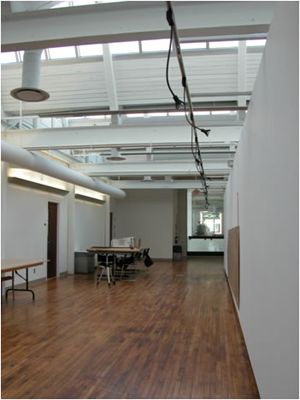
This educational loft is fully lit by north facing skylights, yet the electric lights are on as they have been activated by a motion sensor. The intention was noble, but a light level sensor would have been more effective. |
Progress has been made in the design of sensors that are capable of shutting off entire rooms or areas when they become unoccupied. This answers the issue of “ghost” or “phantom” loads. Phantom loads happen when electric devices such as computers are turned off, but in fact draw a small amount of power to keep them in a standby mode. These loads become significant when attempting to balance the energy in a building and so the use of “all off” systems can assist in eliminating these loads from the equation. Sensors and monitoring systems do not replace the education of the occupants. Occupant education and involvement will be critical in ensuring that many of the passive systems function optimally, but misuse or unintentional overuse of electrical equipment could easily throw off the entire energy balance.
#3 - Use renewables to meet energy needs:
Generally speaking, many of the energy requirements anticipated for carbon neutral buildings may assume electricity for their operation if the intention is to meet most of the energy needs through on site, non CO2 producing renewables. Once the building and equipment have been designed for maximum effectiveness and efficiency, it may be possible to generate 100% of the required electrical energy on site – although site characteristics, location, orientation and sheer size may make this more difficult. Dense urban sites are likely to pose the most difficulty in this regard. In many cases, renewable energy may be more easily met if smaller communities combine their efforts to create shared renewable resources.
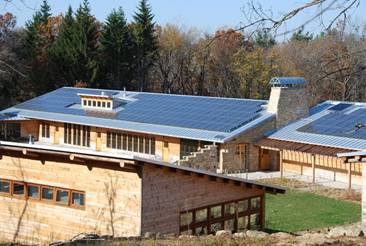
The Aldo Leopold Legacy Center, Baraboo, Wisconsin.
This LEED® Platinum building is also the first carbon neutral building in the United States. The conception of the design began with a budget and resultant area that would be dedicated to the installation of roof mounted photovoltaics. The building’s energy use and size was designed with this limitation. Designed by Kubala Washatko Architects |
The common methods assumed for power generation are: BIPV or non integrated photovoltaics, wind (large or micro turbines), combined heat and power (CHP), and geoexchange systems.
The design of Building Integrated Photovoltaics needs to be incorporated into early design discussions involving the massing and orientation of the building. Surfaces need to be maximized for the architectural incorporation of PV units. Orientation needs to be carefully considered to ensure that the available surfaces are facing the sun at appropriate angles. The latitude of the site will have a direct impact on the "best angle" for installation. In extreme northern climates there are good arguments for mounting the units on the wall surfaces as the general sun angles are low and the climate also suffers from snow accumulation on horizontal surfaces, which will negatively impact production. Overshadowing of the site must be taken into account as many types of photovoltaic cells have impaired performance if parts are set in shadow.
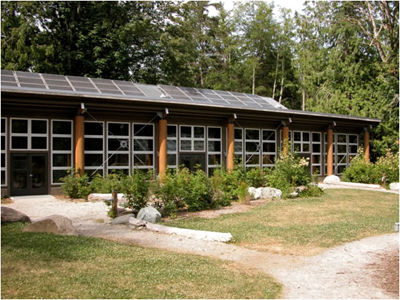
This educational building at IslandWood on Bainbridge Island is situated with its back/north side to a grove of mature trees, with a "solar meadow" on its south side to ensure minimal overshadowing of its sizeable PV array. |
Geoexchange and CHP systems will work on both urban and less dense sites. Wind generation is likely to be the most contentious to incorporate as it is the least architecturally integrated of the systems and due to its appearance and acoustic issues, most likely to generate neighbor issues. As the electrical output of renewables tends to be variable, it is advised to incorporate multiple systems into the project to allow for lulls in generation. This would be particularly advised when using solar and wind systems. If connected to the grid, net metering is likely preferable to battery storage for over production as there are environmental issues with the chemicals and materials that comprise the batteries themselves as well as their limited longevity and subsequent disposal.
#4 - Use purchased Offsets:
Again, if it is simply not possible to balance the energy required to operate the building with renewable energy generated on site, purchased offsets can be used as a last resort when all other means have been looked at on site.
Carbon, Construction Practices and the Site
To this point we have looked at the general concerns with respect to the carbon associated with the materiality of the building as well as its operating energy. Construction practices will also need to be refined to consider carbon. As carbon can be sequestered or stored in the ground as a means of removing it from the atmosphere, it needs to be appreciated that it is also released during excavation and any such processes where land is disturbed. The potential and preservation of the landscape and existing ecosystems on the site needs to be included in design and construction planning.
Site and Location Matter:
Whether you are building on a Brownfield or conserved ecosystem, and whether the site is urban, suburban or rural, will greatly affect the ability to restore or regenerate the ecosystems on the site. The ecosystems of the site will determine the potential for carbon sequestration on site. Where LEED® gives preference to Brownfield sites, unless these undergo intensive replanting and natural restoration, they may prove to be more difficult when it comes to the ability to sequester carbon on site through its natural systems. This is not to say that Greenfield development is better, only that more consideration to the regeneration of Brownfields from the perspective of new planting and new ecosystems will be required to assist in the containment of carbon.
Disturbance is Impact:
Carbon is released into the atmosphere when earth is disturbed. Where LEED® credits require that contractors limit their use of the site for staging to protect the natural ecosystems, the protection of the existing soil and vegetation in this instance is intended to limit the release of carbon through disturbance. Designing the foundations to minimize impact might mean the use of micro-piles or drilled foundations in lieu of an open excavation so that less soil is overturned. Minimizing the moving of soil around the site for earth works will also limit unnecessary carbon release. Disturbance changes existing ecosystems, natural habitats and changes water flow and absorption, which may have other negative effects on the site condition as well. Disturbance can kill trees, lowering the site potential for carbon reduction.
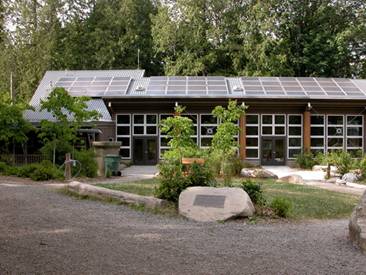
IslandWood, Bainbridge Island, Washington.
The buildings for this LEED® Gold Eco Retreat were all sited to maximize their solar potential. Construction was kept to 3% of the site to minimize disturbance and preserve the natural eco systems on site. The roof of this education building is covered in PV to power the electrical needs of the classrooms. The building design uses passive principles and materials to retain heat and promote cooling. The roof is constructed in a butterfly shape to collect rainwater, which is directed for storage in a large cistern at the front left of the building. Although not specifically designed with carbon neutral as the focus, the project employs all of the base concepts that reduce demand and impact making zero carbon the next logical step. Designed by Mithun Architects. |
Natural Ecosystems Sequester Carbon:
Carbon is naturally stored below ground and is released when soil is disturbed. There are significant scientific efforts underway to look at using the ability for the earth to sequester carbon in massive quantities through injection. Proper treatment of the landscape can keep this carbon in place (sequestration). This is in part related to reducing disturbance of the earth itself, and also related to the type of plantings that are chosen for the landscaping on the project. Proper treatment of the landscape and selection of plant materials can be designed to store/accumulate/sequester more carbon over time. Biodiversity can assist in creating a healthy landscape that is capable of processing CO2. Avoidance of annuals and the selection of perennials and low care ground covers can virtually eliminate the need for tilling and maintenance that disturbs the soil. The addition of larger tree species can increase the capacity of the project to sequester more carbon as sequestration increases with the growth of trees. It is necessary to verify the landscape design type with your eco-region. The recognition of the eco region is to be included in LEED® 2009, but moreso related to energy and climate related issues, and not to the treatment of the landscape. The use of indigenous plant material requires less maintenance/water. Additionally healthy plants absorb more CO2. It is therefore possible to use the natural ecosystems on your site to assist in lowering the carbon footprint of your project
Sequestering Carbon with the Building:
Buildings and material choices can help to sequester carbon. The materials that you choose can help to reduce your carbon footprint and the construction methods associated with materials and systems can also impact carbon production. In a holistic consideration of the carbon issues surrounding the built environment, the energy used to construct the building should also be considered. What types of tools and equipment are used in construction? Electrically powered tools can make use of available Green Power if the renewable sources are not yet in place on the site. The use of heavy equipment adds carbon use to the project as these typically run on diesel fuel.
Wood from certified renewable sources, wood harvested from your property, or wood salvaged from demolition and saved from the landfill can often be considered net carbon sinks. Certified wood is addressed in existing green building protocols as is construction waste management. Harvesting wood in a sustainable fashion from the site property or by arrangement from a local forest is new to the carbon problem. This has been successfully accomplished on the Aldo Leopold Center, the only carbon neutral project in the United States as of 2008.
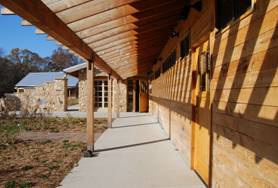 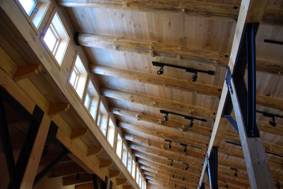
The Aldo Leopold Center started with the sustainable harvest of the Leopold forest. The wood was assessed and sized to maximize the number of structural columns and beams. The remaining wood whose diameter was insufficient was cut into smaller members as well as exterior and interior cladding. The structural system of the building was designed based on the materials list. This runs contrary to normal practices where the building is first designed and the materials ordered (even if limited to a close radius to reduce emissions impacts). |
Incorporating green roofs and living walls into the building design can assist in carbon sequestration and become part of the building itself. These systems have long been incorporated into the LEED® Credit system, but carbon neutral design is looking for their benefit in a more particular way.
|

